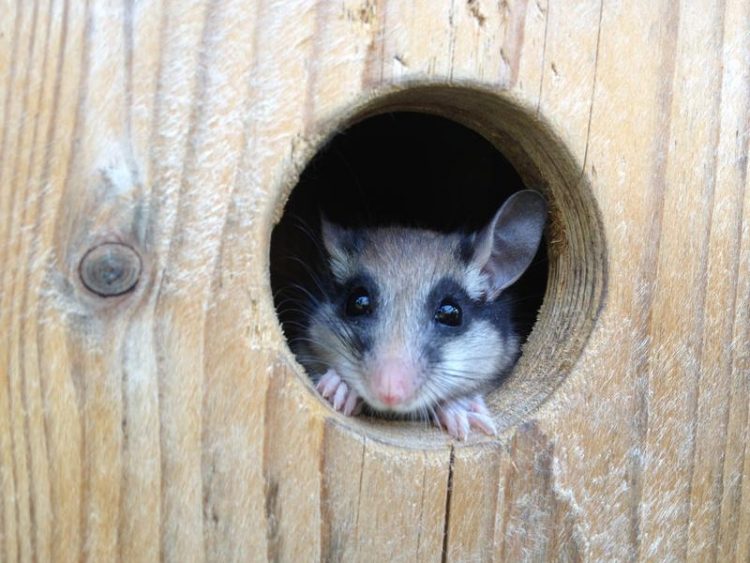The power of the power nap – Scientists uncover secrets of hibernation

The garden dormouse is native to Europe and lives mainly in the forest. Photo: Stefan Stumpfel / Vetmeduni Vienna
Scientists from the Research Institute of Wildlife Ecology at the Vetmeduni Vienna have discovered that power-napping can help late-born garden dormice overcome these unfavourable odds. The scientists also found a link between time spent at higher temperatures and ageing. The results were published in the Journal Proceedings of the Royal Society B.
During hibernation, dormice enter into ‘torpor’ to save energy and water. In this state, the dormice become inactive and show a marked decrease in their metabolic rate, causing their body temperature to reduce.
Torpor was then found to be a strategy used when food availability was limited. The researchers compared two groups of juveniles born late in the season – one able to feed freely and the other intermittently fasted on alternate days. The fasted dormice showed considerably greater use of torpor, enabling them to maintain high growth rates and accumulate sufficient fat reserves. “The longer an animal stays in torpor, the more energy it saves”, says Sylvain Giroud, who led the study.
Torpor use was measured using temperature loggers placed in the nests of the animals, which detected the sharp drop in body temperature occurring during torpor.
“Torpor was only viewed as a means to save energy and water, but during the last decade other functions have emerged. These include promoting growth during early life and fattening prior to hibernation, as well as slowing ageing processes” added Giroud.
Indeed, torpor and hibernation are associated with slowing ageing processes and increase of longevity. In their study, the researchers have also provided the first evidence for a functional link between time spent at high body temperature (euthermic) and ageing processes over winter. “Our data indicate that the main effects of hibernation on ageing processes are linked to euthermic episodes which are associated with the shortening of telomeres, an indicator of ageing”, the researchers concluded.
Ongoing research of Giroud’s group is now focusing on comparing late-born juvenile garden dormice with their early-born counterparts. The early-born juveniles are expected to use less torpor, to grow at a lower rate and to reach higher fattening levels prior to winter hibernation. Giroud and his colleagues are going to investigate the impact of lower growth rates and higher pre-hibernation fattening on ageing. “We hope to unravel the mechanisms involved in torpor use and ageing processes in individuals facing contrasted environmental conditions during their early life”, says Giroud.
Giroud worked together with colleagues from the University of Western Sydney (Australia) and the University of Strasbourg (France).
Service:
The article „Late-born intermittently fasted juvenile garden dormice use torpor to grow and fatten prior to hibernation: consequences for ageing processes“, by Sylvain Giroud, Sandrine Zahn, Francois Criscuolo, Isabelle Chery, Stéphane Blanc, Christopher Turbill and Thomas Ruf was published on the 5th of November in the Journal Proceedings of the Royal Society B. doi: 10.1098/rspb.2014.1131
http://rspb.royalsocietypublishing.org/content/281/1797/20141131.abstract
About the University of Veterinary Medicine, Vienna
The University of Veterinary Medicine, Vienna in Austria is one of the leading academic and research institutions in the field of Veterinary Sciences in Europe. About 1,300 employees and 2,300 students work on the campus in the north of Vienna which also houses five university clinics and various research sites. Outside of Vienna the university operates Teaching and Research Farms. http://www.vetmeduni.ac.at
Scientific Contact:
Dr Sylvain Giroud
Research Institute of Wildlife Ecology
University of Veterinary Medicine Vienna (Vetmeduni Vienna)
T +43 1 25077-7135
sylvain.giroud@vetmeduni.ac.at
Released by:
Susanna Kautschitsch
Science Communication / Public Relations
University of Veterinary Medicine Vienna (Vetmeduni Vienna)
T +43 1 25077-1153
susanna.kautschitsch@vetmeduni.ac.at
Weitere Informationen:
Media Contact
All latest news from the category: Life Sciences and Chemistry
Articles and reports from the Life Sciences and chemistry area deal with applied and basic research into modern biology, chemistry and human medicine.
Valuable information can be found on a range of life sciences fields including bacteriology, biochemistry, bionics, bioinformatics, biophysics, biotechnology, genetics, geobotany, human biology, marine biology, microbiology, molecular biology, cellular biology, zoology, bioinorganic chemistry, microchemistry and environmental chemistry.
Newest articles

NASA: Mystery of life’s handedness deepens
The mystery of why life uses molecules with specific orientations has deepened with a NASA-funded discovery that RNA — a key molecule thought to have potentially held the instructions for…

What are the effects of historic lithium mining on water quality?
Study reveals low levels of common contaminants but high levels of other elements in waters associated with an abandoned lithium mine. Lithium ore and mining waste from a historic lithium…

Quantum-inspired design boosts efficiency of heat-to-electricity conversion
Rice engineers take unconventional route to improving thermophotovoltaic systems. Researchers at Rice University have found a new way to improve a key element of thermophotovoltaic (TPV) systems, which convert heat…



